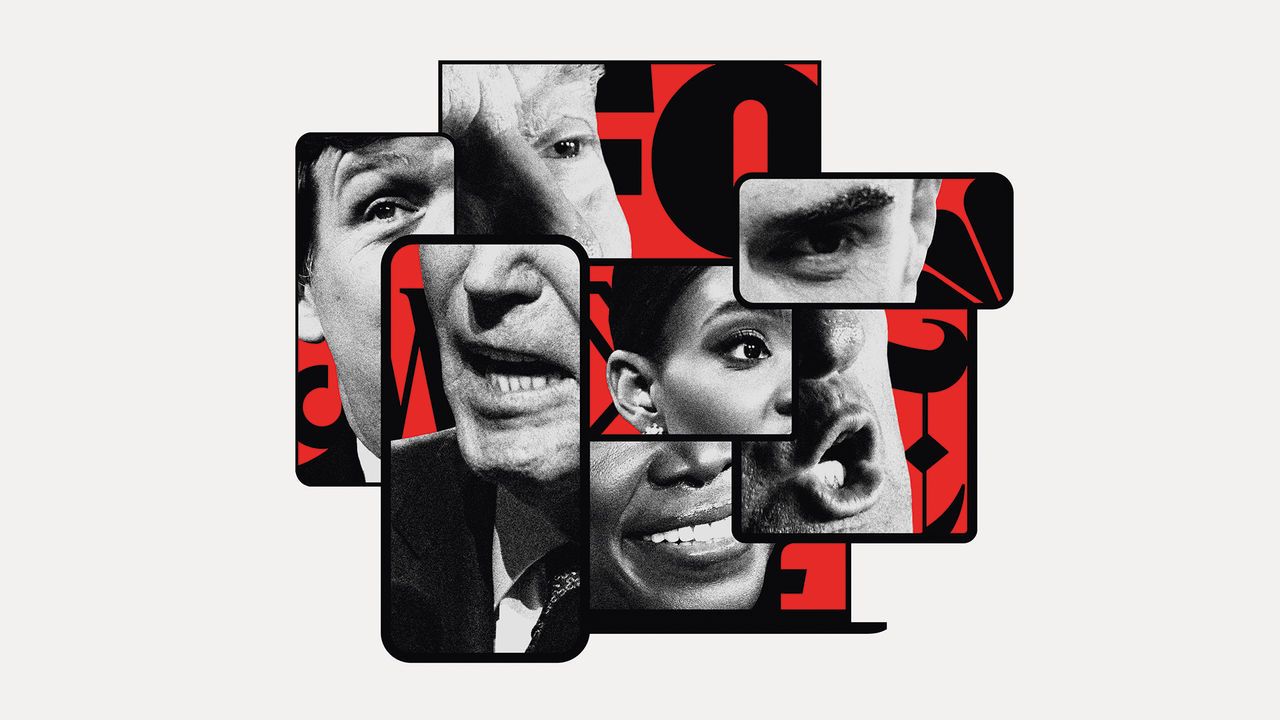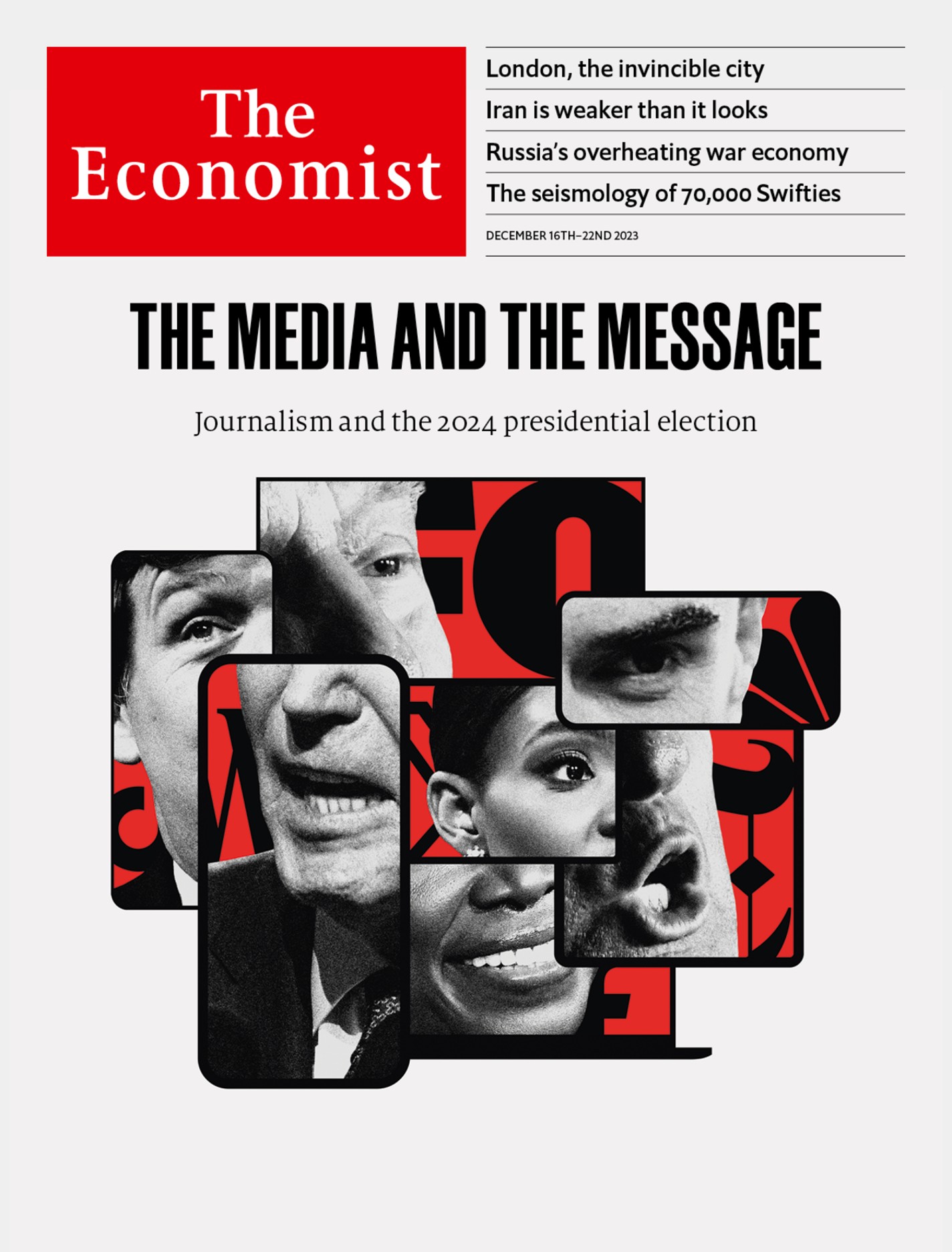Can you have a healthy democracy without a common set of facts?
America’s presidential election is a test of that proposition

Journalists should not spend much of their time writing about journalism. The world is more interesting than the inky habits of the people who report on it. But this week we are making an exception, because the discovery and dissemination of information matters a lot to politics. Don’t take our word for it: “A popular government,” wrote James Madison in 1822, “without popular information, or the means of acquiring it, is but a prologue to a farce or a tragedy; or, perhaps both.” Were Thomas Jefferson offered a choice between a government without newspapers and newspapers without a government, he said that he would choose the press (though that is probably going a bit far).
As the turmoil at America’s elite universities over antisemitism shows, creating a political culture in which people can argue constructively, disagree and compromise is not something that happens spontaneously. In media, business models, technology and culture can work together to create those conditions. They can also pull in the opposite direction. Our analysis of over 600,000 pieces of written and television journalism shows that the language of the mainstream American media has drifted away from the political centre, towards the Democratic Party’s preferred terminology and topics. That could lower the media’s credibility among conservatives.
As the country braces for next year’s election, it is worth thinking about the internal forces that deepened this rift. You can take comfort from the fact that the industry has been buffeted time and again during its long history, yet somehow survived. The worry is that today’s lurch may prove worse than any before.
One of those forces is technological disruption. From printing to the mobile web, new media tend to disrupt authority. That is good news if you live in an autocracy. In America, though, technologies have often brought trouble. Father Charles Coughlin, a pioneering demagogue in the 1930s, used radio to reach a mass audience before Republicans and Democrats got the hang of it. Cable news helped foment a revolution in the Republican Party. It is hard to see how Donald Trump could have become the party’s nominee in 2016 without the ability to speak directly to tens of millions of Americans in messages of 140 characters. Artificial intelligence (AI) will up-end media once again, for good or ill. It may feed mind-scrambling fakery to anyone who hankers after conspiracy. But, for anyone who wishes to know what is really going on, AI may put a greater premium on filtering out the nonsense.
Disruption powers fragmentation. The American media have passed through narrowcast ages and broadcast ages. In Madison’s and Jefferson’s day, narrowcasting was the norm: small-circulation partisan journals spoke to different factions of a small elite. Later, the spread of the telegraph and the penny press created mass media. Narrow partisanship was no longer good business. Advertisers wanted to reach as many people as possible and scarce electromagnetic spectrum, which limited the numbers of radio and television stations, led to a system of regulation. All that favoured objectivity: journalists should try to put their opinions aside and stick to the facts.
Today, however, the smartphone has caused fragmentation and American media are back in a narrowcast age. As much of the advertising revenue that once paid for reporters has flowed to Google and Meta, this has created new business models. There is a lot to like about the subscription-based outfits that now rule: what better test of the quality of the work than whether people will pay for it? But such businesses can also be built on pandering to people’s prejudices. Tucker Carlson was fired from Fox News only to create a new venture as a subs-based, one-man broadcast company. This is closer to a business model the Founding Fathers would have recognised, but rather than creating content for curly-wigged merchants steeped in 18th-century learning, he wants to tear down such Enlightenment values.
This is not just happening on the fringes. Our package this week also contains an essay by James Bennet, our Lexington columnist, a former editorial-page editor of the New York Times who was fired for publishing a piece by a Republican senator that sparked a newsroom revolt. He argues that the Times increasingly affirms its readers’ leftish bias even as it reassures them that it is independent. Unlike the right-wing media, the mainstream lot do not routinely peddle falsehoods or conspiracy theories. But their bias undermines their ability to put the record straight. They used to be like the best public broadcasters in other Western democracies, establishing common facts and setting the boundaries for debate; today, less so.
Why does this matter? Although most Americans do not regularly read a newspaper or watch cable news, elites matter in democracies. When different political camps exist in separate information universes, they tend to demonise each other. If you are told Joe Biden is in the grip of a cabal of antisemitic socialists, then voting for Mr Trump makes perfect sense. If Trump supporters are anti-democratic racists, why bother trying to win them over? As a result, the parties will find it even harder to reach the compromises that are essential for sustained good government. If the elites cannot see the world as it is, they will make bad decisions.
As well as being a problem for politics and journalism, this is also a threat to core liberal ideas: that arguments need to be strength-tested, that insights can be found in unusual places and that encountering opposing views and uncomfortable facts is usually a good thing. These ideas will be challenged by newsrooms that see “objectivity” as a sleight of hand which privileged groups use to embed their own power. Old-style liberals may have to adapt to AI-powered business models that reward those who tell people everything they already think is true is true.
Breaking news
America progressed from narrowcast media and a limited franchise in the early days of the republic to broadcast media and universal suffrage. It has never had narrowcast media and universal suffrage at the same time. As a newspaper founded to promote classical liberalism, The Economist would like to think they can coexist happily. Next year’s election will be the test. ■
For subscribers only: to see how we design each week’s cover, sign up to our weekly Cover Story newsletter.
Explore more
This article appeared in the Leaders section of the print edition under the headline "The media and the message"
Leaders December 16th 2023
- Rishi Sunak’s strategic genius
- Can you have a healthy democracy without a common set of facts?
- Iran’s regime is weaker than it looks, and therefore more pliable
- The Fed gives in to the clamour for looser money
- London’s resilience is a lesson to policymakers everywhere
- In a first, COP28 targets the root cause of climate change

From the December 16th 2023 edition
Discover stories from this section and more in the list of contents
Explore the editionMore from Leaders

How to detoxify the politics of migration
Doom-mongers on both the left and the right are wrong

Economists had a dreadful 2023
Mistaken recession calls were just part of it

The Economist’s country of the year for 2023
It is possible to enact painful economic reforms and still get re-elected